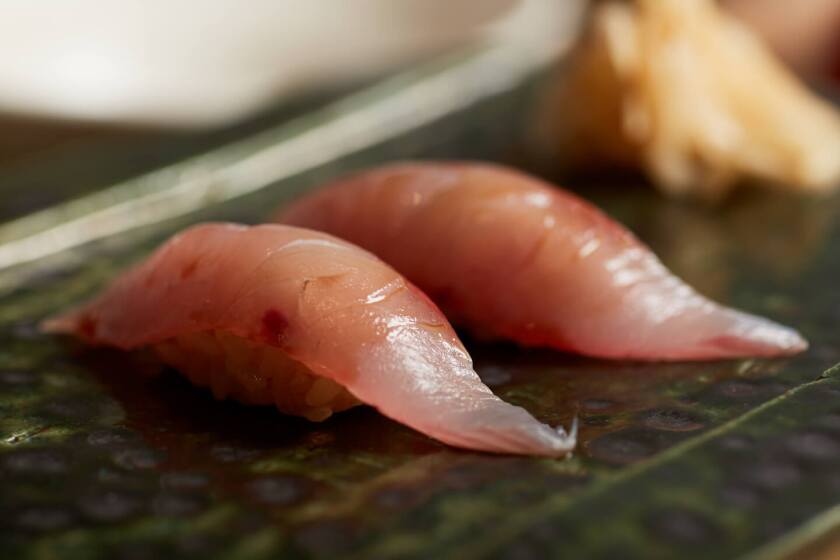Morihiro “Mori” Onodera, like the relaxation of us, experienced other strategies for 2020.
The revered sushi chef — a delicate-spoken bespectacled determine accountable for education what would seem like 50 % of Los Angeles sashimi experts — experienced left his post at the upscale Japanese place Inn Ann in late 2019, two months in advance of the cafe shut for superior.
By then Onodera experienced started sketching out his upcoming job, an personal sushi bar in Atwater Village that would provide as a end result of the decades he has expended mastering the craft.
He envisioned a high-close sushi counter that presented $300 omakase dinners at evening. Six seats at a white oak bar. A handful of tables.
But at the time COVID-19 strike, Onodera understood his business enterprise idea experienced to modify.
“I determined to make it far more inexpensive,” he mentioned. “The food stuff will generally be really good high quality, of training course, but this time I will try to hold the rate as small as feasible.”
For people who have at 1 time or an additional splurged at a single of Onodera’s institutions, this statement is not insignificant. At Mori Sushi, the Michelin-starred West L.A. restaurant that he ran for in excess of a decade ahead of marketing it to his assistant, the sushi omakase ran a couple hundred bucks at least. The exact was genuine at Shiki Beverly Hills, the ritzy restaurant he oversaw in 2017 before relocating to Inn Ann.
But at Morihiro, his new restaurant on Glendale Boulevard that opened in November, he’s making ready takeout bento packing containers that start out at $27 (vegetarian) and $37 (combined), a modest price tag by Onodera requirements.

Nigiri sushi at Morihiro
(Ibuki Kobayashi)
Sushi lovers can get a $50 omakase established that includes six pieces of nigiri, a reduce roll, an appetizer and miso soup. Onodera selects all the seafood himself, a lot of it flown in from Japan: fatty winter season yellowtail, baby barracuda, golden eye snapper, etc.
He steers very clear of bluefin tuna on theory (it is extremely overfished), preferring to showcase his like of hikarimono, silver-skinned fish these as gizzard shad, sardine and horse mackerel identified for their stronger taste.
The cafe house — a narrow 1,000-square-foot room with a bare-bones open kitchen area — is connected to Viet Noodle Bar, a community Vietnamese cafe run by Onodera’s longtime buddy Viet Tran. The two worked out a offer that permitted Onodera to build out his have kitchen area and dining area even though sharing a prep region and restrooms with the larger sized cafe upcoming door.
“I imagined it was the ideal dimension for earning sushi,” Onodera stated. “Many men and women questioned me, ‘Are you absolutely sure you want to open suitable now?’ But for the reason that this is not a significant cafe, it is less complicated. The compact house is at ease for me.”
With the cafe shut other than for takeout, Onodera is planning all the food items himself and packaging orders with the support of an assistant.
Ultimately the menu will involve his edition of a regular Japanese breakfast: heat rice, pickles built from community make, fresh tofu, a rolled egg omelet, soup, some sashimi or grilled fish.

A seasonal bento set at Morihiro
(Ibuki Kobayashi)
“It’s a stunning assortment of breakfast,” he mentioned, describing his eyesight of a tray crammed with 10 or so little dishes that would expense all-around $20. “Very straightforward, but it requires a large amount of talent to get ready.”
The chef’s longtime fans could recognize other trademark touches at Morihiro. An completed potter, Onodera crafted all the restaurant’s ceramic dishware — about 300 plates, he estimates.
Then there is the rice.
Onodera is regarded for proclaiming that terrific sushi is 70% rice and 30% fish, and his document speaks to that obsession. Previously he’d partnered with farmers to expand a precise wide variety of small-grain koshihikari, initial in the Sacramento Delta and afterwards in Uruguay.
These times he’s organized a agreement with a rice farmer in the Ibaraki prefecture of Japan mainly because he believes the region generates some of the most exquisite and flavorful grains on the planet.
“The greatest rice for sushi arrives from Japan. Some men and women talk to me, ‘But what about California?’ I’m quite sorry, no contest.”
Not just one to restrict himself, he’s also putting in his individual rice polishing device, which will allow him to mill unhusked brown rice at the restaurant so it retains most dampness.
“Everything below is unique,” he said. “It’s my food items, my plates, my eyesight.”
In spite of the logistical problems of debuting all through the pandemic, Onodera is upbeat about the potential of what he phone calls his “dream restaurant.” Need for on line pickup orders has previously shot past his early anticipations.
And when dining rooms are permitted to reopen, he sooner or later wants to introduce all those $300 omakase dinners. For now, he’s just as fired up about serving $5 rice balls stuffed with sour plum or seasoned bonito flakes.
“I’m 56 a long time previous. I never assume about retirement. I’m thrilled to get the job done and introduce additional men and women to standard Japanese food items. It can be high-priced but not generally,” he explained.
3133 Glendale Blvd., Los Angeles, (323) 522-3993, morionodera.com